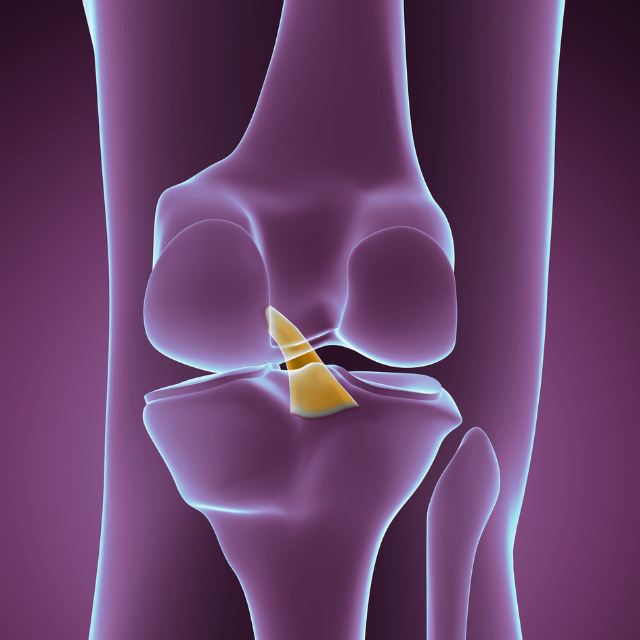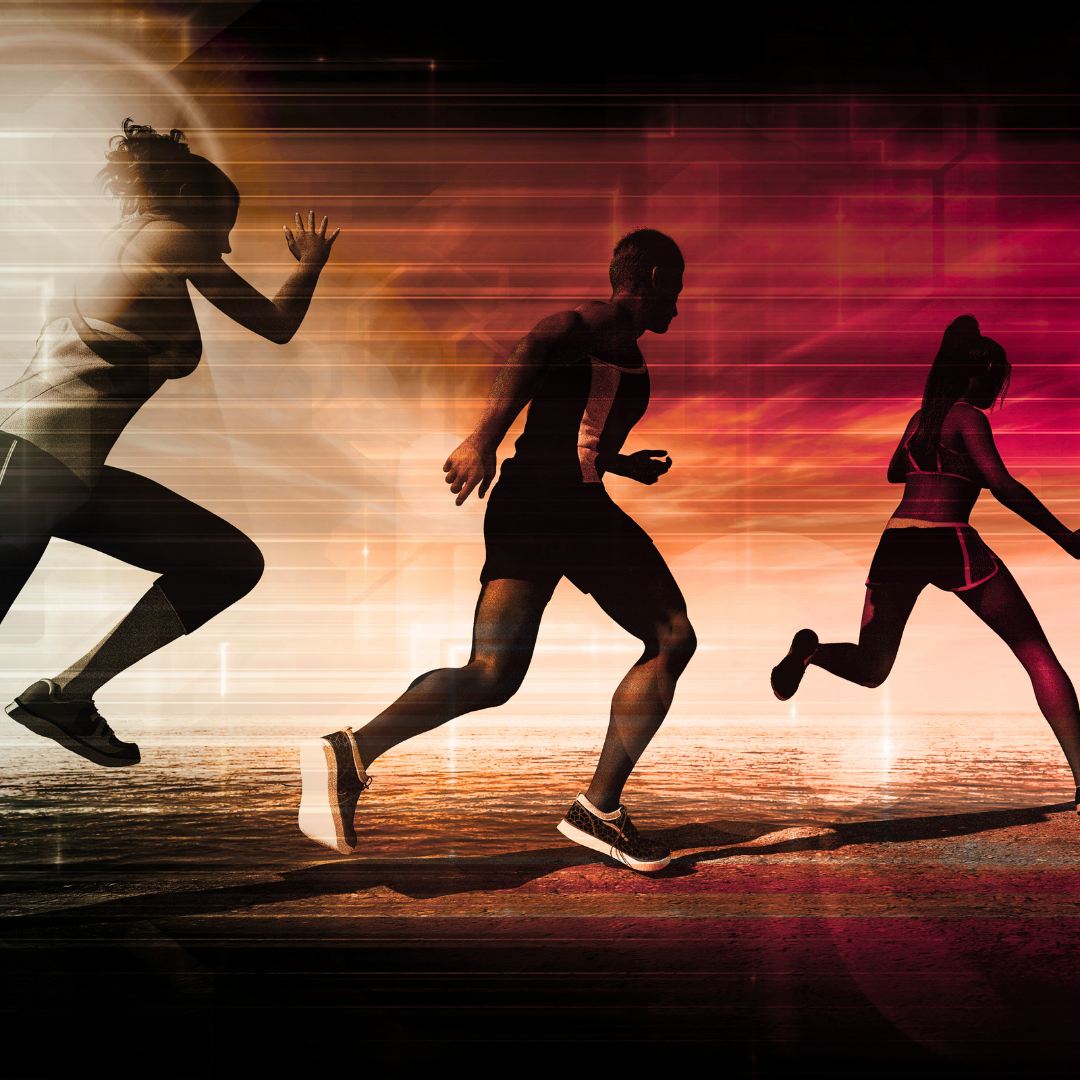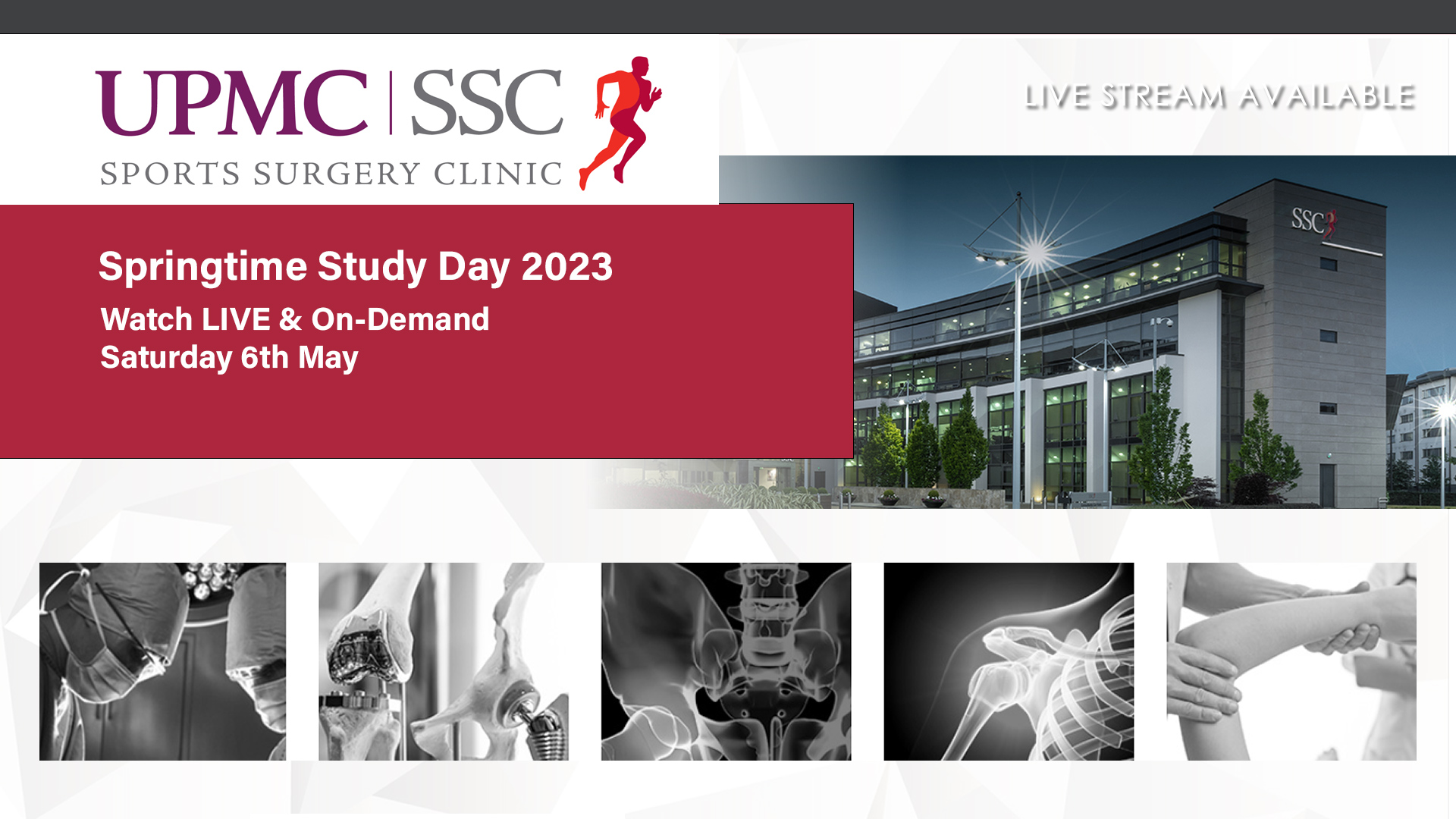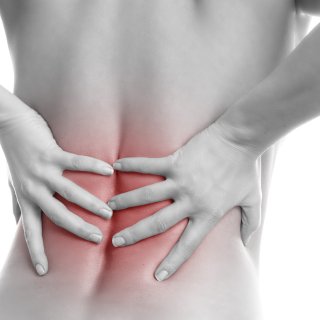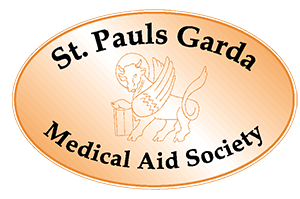Watch this video of Colin Griffin, ASCC, Lower-limb Rehabilitation Specialist, UPMC SSC Sports Medicine Dept talking about building running robustness.
This video was recorded as part of UPMC Sports Surgery Clinic’s Online Public Information Meeting, focusing on Common Running Injuries and Building Running Robustness.
Dr. Colin Grif fin is a rehabilitation specialist and a PhD-level expert in foot and ankle rehabilitation. He is keenly interested in calf and Achilles tendon injuries and lower-limb running injuries.Colin initially obtained a BA degree at the University of Limerick and a degree in Strength and Conditioning with Setanta College before achieving an MSc in Coaching and Exercise Science at University College Dublin. Colin enjoyed a 15-year career in elite sport as an international athlete representing Ireland at all levels, including the European and World Championships and the 2008 and 2012 Olympic Games in the 50km walk.
fin is a rehabilitation specialist and a PhD-level expert in foot and ankle rehabilitation. He is keenly interested in calf and Achilles tendon injuries and lower-limb running injuries.Colin initially obtained a BA degree at the University of Limerick and a degree in Strength and Conditioning with Setanta College before achieving an MSc in Coaching and Exercise Science at University College Dublin. Colin enjoyed a 15-year career in elite sport as an international athlete representing Ireland at all levels, including the European and World Championships and the 2008 and 2012 Olympic Games in the 50km walk.
Good evening, everybody I’m looking forward to presenting to you this evening on building running robustness given that there is a running injury theme to this and maybe discussing some things you can do to minimise the risk of injury and to help to make yourselves more robust as runners either yourselves if your athletes or as coaches with your athletes.
So, a basic outline in the webinar is we will go through some injury risk factors and overuse injury models or what we think we know of how these overuse injuries occur because most running injuries are overuse injuries. You can get the odd acute injury. We we’ll discuss some of the common running injuries and what we know about them. I’m going to give an overview of the biomechanical demands of running and discuss then strategies to build robustness and to prevent or minimise the risk of developing an injury.
I suppose the first thing to consider is that our bodies are designed to adapt every system in the body whether it’s our energy system whether it’s our you know hormonal system, nervous system, muscle tissue and anything else it is designed to adapt. There’s a very old model that’s kind of stood the test of time called the general adaptation syndrome by Hans Selye a Hungarian sport scientist. This applies to any sort of aspect of biology, and we’ve got a baseline, that could be a baseline level of fitness, that could be your tissue whether it’s muscle tissue, bone tissue, tendon tissue or cartilage. So, we’ve got the baseline and if we want to change the baseline, we got to give it some stress so when we train, we apply stress to the body and as a stress applied our baseline will temporarily drop because our system is fatigued, It’s under stress. Alarms go off; hence, it’s called the alarm phase. Once we give ourselves enough recovery time, we get a chance to recover and our fitness level or our capacity will increase. So, it is important to have that sufficient recovery time and that recovery time that window is known as resistance phase. This is where we’re starting to become resistant to that stress that is applied and our capacity goes up, it’s called super compensation, and we reach a new baseline level of fitness or tissue capacity and so on.
However, if we don’t adapt adequately or sufficiently, whether that’s because we overload, the stress is too much at a moment in time, we haven’t had enough time to recover, we’re operating at a low level of capacity on that given day or week, or they haven’t factored in the accumulated load and fatigue over the preceding days or weeks. We don’t adapt and the alarm phase I suppose extends a little bit further and their ability to recover becomes compromised and takes a little bit longer and if we don’t allow for that adequate window and try to apply more load on while recovery hasn’t been fully complete then you know we’re at risk of some sort of a performance decrement or risk of injury or illness or some sort of negative adaptation.
So, this paper by Tim Gabbett was published earlier this year and just a nice illustration of how we can apply that general adaptation syndrome model to tissue. He’s, I suppose, taken some of the best evidence that we know for different tissues like cartilage, bone, tendon and muscle and you’ll see that there are different depends on the stress applied obviously you’ll see that there are different recovery windows for each tissue. So, for cartilage you know when we apply repetitive sort of impact loading cartilage can recover quite quickly within 30 minutes after a loading bout. That could be hopping, that could be landing, something that’s kind of short and intense. Obviously, the cumulative running is a little bit different, but cartilage is designed, it’s compressible, deformable, it is designed to repair itself and recover in normal circumstances. Obviously, cartilage does break down over time and as athletes and even non-athletes get older, you know, other factors such as metabolic factors, inflammatory factors can impact the cartilage’s ability to recover and adapt. Bone can also recover quite quickly after short bouts of high-intensity loading. So, doing something like hopping or skipping or even sprinting, you know, the bone tissue can recover within 48 hours. Obviously during extended running periods, that can take a lot longer.
Tendons, normally when we apply high intensity loading to a tendon, whether it’s like plyometric exercises or sprinting or something of high intensity nature, it does take 48 hours or so to recover properly. Then if we apply high intensity loading to a muscle particularly fast eccentric contraction, so, eccentric is when the muscle fibres lengthen under tension. That does take you get DOMS (Delayed Onset Muscle Soreness) afterwards if you’re not accustomed to it. And that can take up to 72 hours or more to recover. So again, it’s important to keep that in mind different tissues take different time frames to recover and adapt.
So, it’s essentially when an injury happens that tissue fails to adapt for some reason and usually there’s a mismatch between load applied to the tissue and the tissues capacity to handle and adapt to that load and I suppose load and capacity can mean different things. So again, this is quite a busy flowchart, but if we just work through it, on the left, we’ve got capacity and if you look in the top left, that’s your tissue capacity at the start of a training session or a given week and that can be influenced by your previous training, how many years of training you have behind you, or even that given season, how many weeks of good, solid, consistent training you have behind you, your previous injury history, your diet, your sleep, your genetic factors, and the time between training sessions, or whether you’ve recovered adequately between your previous high intensity or high volume or high load training session. When we’re fatigued, you know that our tissue capacity can temporarily reduce, if we do a hard session or if we accumulate a number of high demanding sessions over a period of time, that tissue capacity can reduce temporarily. On the right-hand side, if you look at load, there’s different I suppose factors involved here. There’s a load per stride; that’s the force going through the body. At an internal level, the force going through the tissue. That can be influenced by speed duration and also the terrain you’re running on whether it’s hilly ground flat ground and uneven surfaces versus solid surfaces.
Then there’s a load distribution per stride because when we you know put load through the body you know different tissues can experience different stresses and that can vary from person to person. So, someone’s anatomy and body shape can differ from someone else and that can influence where that load goes. Someone’s running mechanics and style can also impact where the load goes throughout the body. Also running shoes, you know, different running shoes, different shoe types can have different impacts on different people, you know, whether it’s your kind of heavy or more foamy type shoes versus your more minimalist type shoes and also surface, so soft surfaces can vary where the load goes hard surfaces maybe less so. But again, not that one surface is good or bad, it’s what you’re accustomed to. If you change footwear or change your habitual running surfaces and you’re trying to do the same training load that, can I suppose change how the stress is applied to the body and that can be a bit of a risk factor if you’re in a fatigue state doing that. Then I suppose when we look at that load how it adds up the number of strides in a given session and also the tissue load per stride and then how that accumulates over the session or over the week or training cycle. Essentially when we’re in a fatigue state we go back on the left our capacity is lower and we have a high cumulative of load built up and the tissue capacity is exceeded and then we’re at a high risk of a running injury.
We’ve also got to factor in the non-training stressors because it’s one thing you know stress in the body and recovering properly but also other non-training stresses can impact the body’s capacity or the tissues capacity at a moment in time. If we take a typical day for a typical athlete and you know if you assume that you dedicate two hours to your training in a day you work or study for eight hours you might have a 1-hour roundtrip commute to work or to university or to school if you’re younger athlete. You might have some social activities or if you’re a parent like myself, you might have your kids’ activities in the evening that could take up to two hours. You might sleep for 6 to 8 hours and then you might have three hours there to play with for free time. So, I guess you know we think about the training time, but we often don’t factor in the other stressors the other time the other 22 hours in the day and that could have an impact on how you are able to recover and adapt to a training stress or a training stimulus on a given day or a given week. So, if your work is stressful or you’re if you’re a student coming up to exam time that’s an extra stress in the body that can temporarily reduce your capacity to handle training or delay your recovery time and if you don’t allow for that in your training that can predispose you to injury. If you get poor quality sleep, so, it’s not so much how long you sleep, but it’s the quality of that sleep. If you’re lying in bed for 10 hours, but you only get about four hours of quality sleep, that’s not great. Whereas, if you go to bed for six or seven hours, and you know, six hours of that is good quality sleep, but that’s good. So, again, most people probably need on average six to eight or even nine hours of sleep, but the quality of that sleep is quite important. Also, how you manage stress whether it’s you know you know stress in the work environment stress in your education environment stress at home and other things that can also elevate your injury risk if it’s not managed carefully.
Most systematic views looking at common distance running injuries have pretty much similar findings and this is one by Peter Francis back in 2018. The first image here looks at the site of injuries and you’ll see on there that the knee is the most common site of injury. Again, you can have different injury on the knee most common is patellofemoral pain syndrome, which is injury to the patellofemoral joint, but you can also have other knee pathology such as Iliotibial band syndrome, patellar tendinopathy, a meniscal tear and so on. Other injuries are at the shank area, which is like your shin area and calf, that could be like medial tibial stress syndrome often referred to as shin splints which is a bit of an umbrella term not one, I like to use but anyway that’s neither here nor there or even calf injuries and Achilles injuries. Then your foot and ankle area you know ankle sprains Plantar Fasciitis for Plantar Fasciopathy, metatarsal stress fractures or other bone stress fractures of the foot. Some of these are broken down so again Patellofemoral Pain Syndrome is the most common injury diagnosed from this review Achillis Tendinopathy comes in second, Medial Tibial Stress syndrome, Plantar Fasciitis, Iliotibial Band Syndrome and so on, Calf strains, meniscal injuries, stress fractures. The main thing from this is that two-thirds of running injuries occur from the knee down so there’s a probably a message in that.
If we do a basic needs analysis for running, you know, because when you look at most strength training programs and advice for running, people focus a lot on the glutes, the core, and all the rest and probably neglect the muscles lower down that are quite important. One study done in 2012 using musculoskeletal modelling determined that at around steady state running speed which is around lactate threshold pace for most people the calf muscles, the gastrocnemius muscles, are the biggest force producers. they produce forces of around eight times body weight so quite large. Next in line are the quads and then the hamstrings, the glutes and hip flexors. The calf muscles are the big players when we’re running or even when we’re jogging.
If you look at some of the chronic running injury sites, particularly the joints and around the knee and the and the lower limb area. If you take the external ground reaction force going to the body when we’re jogging, that’s around twice body weight, when we’re running slow to steady, that’s around four times body weight and when someone’s sprinting, that’s about six times body weight. That’s the external force going through the body and if you look at the ankle, the contact force at the ankle joint, so think of that almost like a suction pump at the ankle, so that kind of bone and bone contact which is cushioned by cartilage and lining around the bones and the articular surfaces. That’s around 10 to 14 times body weight. The force going to the Achilles tendon as it stretches is about six to eight times body weight at kind of typical steady state running speeds. The knee joint contact force is around 7 to11 times body weight and the hip joint contact force are 7 to 11 times body weight as well. So, a lot of forces, a lot of stress going to those common injury areas. And I suppose the question is how we are prepared to handle those stresses over and over again.
If we look at some of the common running gate features associated with running injuries this study by Chris Bramah in University of Salford in Manchester took a cohort of runners who had different lower limb injuries and look at some of the common features compared to those who are not injured. You see on the left in a side view someone who overstrides so lands a little bit more on the rear foot and the shin angle is a bit more negative or angled and the foot is a little bit further in front of the body and a slight forward leaning compared to the image B where someone lands slightly more mid-foot and more of a vertical shin the foot a little bit closer to the body and a more upright torso. Then if you look at rear view on the far right, you’ll see in image A the athlete has a what we call a contralateral pelvic drop so, when the right leg is supporting them their left
hip or pelvis drops or tilts a little bit. You’ll see the right knee twisting in and you’ll see a lot more rotation you see more of the toes on the foot from behind. So a lot more rotational forces going to the body there compared to that in image B who has a more horizontal pelvic line has a less twisted in looking knee or thigh and there you look from their ankle up to their hip it’s a lot more vertical compared to the athlete on the left in A who’s got a lot more where the knee sits a little bit more deviated in medially from their ankle and their and their hip. Now there are people who run and have some of those negative features who don’t get injured. So, you know biomechanics is one thing, strength is another thing as well but the key thing here is you look at all relevant factors that might load the body and also influence the body’s capacity to handle that load. For athletes who are more at risk we try and influence those factors as said, if someone is a world class runner and looks like both those images and they’re not injured, they’re operating at a high level you mightn’t change those mechanics too much because that might come at risks because if we change someone’s mechanics we’re shifting load from one structure to somewhere else. So again, there’s got to be good logic to do that. If someone has a recurrent injury, the rim of those mechanics and those loading patterns are relevant to the injury obviously then we will try and influence that. So again, it’s a little bit of common sense and logic. Some of these features that are seen are associated with patellofemoral pain syndrome, medial tibial stress syndrome, Achilles tendinopathy and Iliotibial Band Syndrome. A follow-up study in different cohort of athletes found similar running features with people who’ve had previous calf muscle strain injuries.
So, if we kind of look at the calf muscle, which I’ve kind of emphasised quite a lot, and again, I don’t want to overplay one muscle group in particular, but they are for long-distance runners, they’re actually quite relevant muscles, and they’re quite big muscles as well. So, for most people, you know, if you look at some from behind, you’ll see the superficial calf muscles, which is the lateral gastric muscles, muscle head, the LG as illustrated on that image, and the medial gastrocnemius muscles, MG. Then the deeper muscles which is not very visible is the soleus muscle which is the biggest of the three muscles. So, your calf muscles comprised of three muscles. Those three muscles fuse to form the Achilles tendon. And as I said that the most dominant lower limb muscles during slow to moderate speed running and at around lactic threshold pace which is like marathon speed or upper end of someone’s zone two, they operate around 85% of the maximum force capacity. Whereas the quads might operate at around 65% of their maximum force capacity at that speed and maybe the glutes and the hamstrings and hip flexors might operate more at 40-50% of the maximum capacity. And obviously those lateral muscles those glutes and hamstrings and hip flexors their force output will increase quite exponentially at sprinting speed but at jogging speeds they’re operating at a lower capacity at the maximum force. Those calf muscles are packed with a lot more short fibres and mainly slow twitch which enables high force output and efficiency. So, a lot of force is spread across a lot of fibres, and they’re not designed to contract fast or to lengthen and shorten that much, so, they can quite efficient and they’re slow twitch so they can recover very quickly in a normal healthy muscle. But it’s also important that the calf muscle has got a good Achillis tendon so that enables the muscles to contract efficiently.
So, if we go through some of our common injuries an Achillis Tendinopathy I suppose is probably the second most common report injury among distance runners. And if we look at the image on the left, a healthy tendon has got that sort of very organised collagen structure. So, you’ve got collagen molecules that make up collagen fibrils, collagen fibrils make up collagen fibres, Bundles of fibres are called fascicles, and then the tendon is made up of bundles of fascicles. In between those collagen fibres, you’ve got cells called tenocytes which help to regulate the tendon’s homeostasis. So, it allows it to maintain its properties and enables it to adapt or when it’s when the load is too much or hasn’t got the ability to adapt to that load those tenocytes can become overactive and cause the tendon tissue to break down.
You see an example at the bottom of a tendinopathy where you’ve got a less organised collagen structure. You’ve got a bigger population of those tenocyte cells, they lose their shape and they become a lot more rounded as opposed to kind of more spindle shape, you get a lot more blood vessels and sprouting of nerve endings into the core of the tendon which don’t normally reside there in a healthy tendon, they normally lie in the periphery. So, you see an example on the right of notice an image of someone with a with a tendinopathy. The top of the image not sure if you can see my cursor that’s the skin side, the bottom of it is the top of your Kager’s fat pad which is like a triangle between your heelbone and your calf muscles. And where my cursor is if you can see it that’s the bottom of your soleus muscle. So that area there is your mid portion, that’s the most common sight of Achilles tendinopathy. Yes, you can get a tendinopathy at the heel insertion but what you see is kind of a swelling of the tendon. So, a normal tendon has about 4mm of thickness when you look at its side on but a but a pathological tendon with a tendinopathy that that can actually double or even triple in some cases. So, this example here actually had thickness of 12 mm and normal healthy tissue has like grey sort of strands that are quite continuous or look continuous and then you see the tendinopathy region has kind of a dark area where you’ve got breakdown of collagen fibres, you’ve got it an increase and accumulation of water molecules. So, the best way to describe this is like a healthy tendon looks like a pack of dry spaghetti and with a tendinopathy it’s like having a pack of dry spaghetti with a wet patch in it where those spaghetti strands become thicker and kind of gooey and puffy. So, it’s probably the best way to describe an analogy to use for a tendinopathy. You get a breakdown in collagen structure in that region extra water molecules that region is less tolerable to load going through it and when you have a tendinopathy, it can impact how the calf muscles, the structure and the function of the calf muscles. So, you know the calf muscles the fibres can shorten that even one head of the calf muscles often times with a tendinopathy it can be the lateral gastric muscle can shrink and can waste and the tendon fibres from that muscle can detention and that can alter I suppose the how the calf muscles are loaded and that can predispose and to recurrent injuries or even a subsequent calf strain.
But I suppose there’s more things than training that influences the tendon health. You know obviously someone’s muscle strength and capacity is quite important, again how the three muscles and the tendon coordinate, the mechanical properties of the tendon, how elastic or not elastic they are and the capacity of the calf muscles. So that’s important for tendon health. You know training load and physical activity levels tendons like routine, so when the load applied or the increasing load is too much for the tendon to adapt to in a moment in time again it can trigger a negative reaction from the cells and cause collagen tissue to break down and for a tendinopathy to occur. Then age obviously older people some of their tendon properties can reduce, certain medications like certain antibiotics & steroids can influence tendon health in a negative way.
Biopsychosocial factors, you know, when you got a sore tendon and you’re stressed and you’re worried about it, that can amplify the pain response and especially if you got kinesis phobia, you’re afraid to do something in case it makes it worse. And other systemic health conditions such as metabolic disorders, If you if you’re predisposed to diabetes or other metabolic disorders for females, hormonal fluctuations, menstrual cycle, it can impact tenant health and certain autoimmune conditions like rheumatoid arthritis or other I suppose anthropic conditions can also impact tendon health because it can it can trigger or fuel an irregular inflammatory response that can predispose someone to a tendinopathy or slow down the tendons ability to recover and adapt. Calf strains are quite common as well, often times there’s a gradual onset especially in distance running. Sometimes you can get that kind of quick kind of feeling like a dagger going through the calf. So, your more superficial calf strains like the bottom of the medial gastroc and that can feel like a like that can be a sudden onset you can feel it there and then sometimes with a soleus strain it can be a gradual onset. You wake up the following day and you feel like you got a tight calf, and you just warm it up and stretch it and foam roll it and hope for the best, doesn’t often work like that. I’m always a little bit caged when someone comes in and say they got a tight calf and it’s been on for a few days and the point where they’re struggling to run, you know, you can’t just work that out, so yeah, I would be kind of suspicious of a calf strain and I would definitely try and get an MRI scan, especially for the soleus because you won’t pick it up easily, even the most skilled sonographer, you can’t fully relate a soleus strain with ultrasound. Whereas you can with a medial gastro strain. An MRI scan is the recommended go-to to properly diagnose a calf strain, especially those deeper muscles.
Older athletes are a bit more predisposed, those who have had a previous lower limb injury such as a previous calf strain, a previous Achilles tendinopathy or a previous ankle strain, can have a higher risk of a calf strain or a recurring calf strain. So, if you develop a tight calf and it’s going on for a few days, I will assume it’s a strain until proven otherwise by an MRI scan. Because otherwise those days can become weeks and those weeks become months and you’re in the vicious cycle of trying to train, breaking down again, trying to train again, breaking down again and lacking that bit of consistency.
Some bone stress injuries. So again, there’s a I suppose bone stress injuries are kind of operate along a spectrum. So, you can have like say for the medial tibia, you can have like a reaction or an irritation or an inflammatory response around the periosteal area, which is where the muscles sort of anchor to the bone and it’s quite an innervated area where you have a lot of sensory nerves and that can amplify the pain response even though it might look too bad in MRI scan because you got muscles sort of fractioning off that periosteum. Then you can have um some bone stress. So that outer layer of the bone that becomes irritated, and you get some bone edema, and I suppose a low-grade sort of stress response not quite a stress fracture but then you can move up to the grades when you get a proper fracture line then that’s when you’re in a lot of trouble. Basically, you got a breakdown of bone tissue which is a normal response to training and an inability of that tissue to sort of replenish or to repair itself on demand. That process could be going on for weeks or months not necessarily one session. Certain bones have a high risk and need to be managed very carefully compared to other areas. So, if you got you know a bone stress injury to the medial tibia you know again the prognosis is quite favourable you know that there’s lower risk. If you got a bone stress injury to the fibula or the lateral ankle area again the prognosis is favourable because of the bone’s anatomy and geometry, the shaft of the femur again the risk is quite low of any complications. The same around the pelvis same around the calcaneus and the diaphysis. So, a certain region of the second to fourth metatarsals. The high-risk areas are the neck, the femur and the front of the tibia the media malleolus or the medial ankle the tails which is like in your ankle that kind of floating bone in the ankle that only doesn’t have any muscle attachments it has ligament attachments, so it doesn’t get much blood supply and the risk of a tail stress fracture that’s not managed carefully you can get a vascular necrosis which is definitely something you don’t want to be at risk for.
Navicular also can be quite a complicated one as well and again there’s also a risk of, I suppose non- infusion of the fracture and a risk of a necrosis which is like a dying of the cells and certain regions of the fifth metatarsal and the base of the second metatarsal and the sesses of the big toe. Again, they got to be managed carefully if you have a diagnosis of a stress fracture in those areas. Certain factors that impact how load is applied to the bone so, there’s biomechanical factors, ground reaction force forces, your body shape and alignment, your running mechanics, training factors, so the duration, frequency training sessions, the recovery windows, intensity and speed, your muscle strength and endurance. So again, the muscles around bones act like struts to kind of control the load going through the bone because even though the bone is it seems like a hard structure, it is quite pliable. So, the bone is trying to bend or deform when there’s load going through it and those muscles help to buffer some of that. So, if we’re lacking muscle strength and the bone gets stressed a lot more. The calf muscles and particularly your tip post and your paranal muscles are quite important for the tibia and fibula respectively, your foot intrinsic muscles are quite important for you know your metatarsals and navicular bone and so on. The training surfaces and terrain, and again, it’s not that one surface is good or bad, it’s when you try to adapt to a different surface while doing the same training load is an extra stress in the body, the same comes to footwear. There’s no right or wrong with shoes that you can sort of apply across the board, everyone responds differently to the same shoes. But if you change your footwear, don’t allow a proper habituation period and do your normal training that’s an extra stress in the body, the muscles are going to get tired trying to adapt to that and that can increase bone loading in any other tissue. Other intrinsic factors you know that can influence the bone’s ability to handle a load or genetics diet and nutrition. So especially if you’re depleted for long periods of time the bone metabolism will slow down. Calcium and vitamin D is also important for bone metabolism. Hormonal status is also important particularly for females you know who are of menstruation age. You know your physical activity history, so again, the more training you have in the bank and more consistent training you have in the bank, the more robust you are to weather storms and to handle training load. If you have low bone mineral density and risk of, you know, osteoporosis, that’s going to be a complication that can influence the bones’ ability to recover and adapt. And again, certain medications can also be can also weaken the bone and impair its ability to adapt.
So, some of the common strength assessments we do in the clinic we’d measure calf peak torque or peak strength usually on an isokinetic dynamometer and we would do it at a speed of 30 ° a second. So, you’re pushing out with the foot we also pull back in to work to measure shin strength. But typical strength measure we look for recreational sports person being able to produce torque peak, so torque is like rotational force or leverage force 130% body weight or 1.3 times body weight, for a sub athlete you know one and a half times body weight and for elite sports person somewhere upwards of 170 % body weight to twice body weight. Sometimes they might do a seated calf isometric strength test to get a measure of soleus peak force. Again, we’re looking for one and a half to twice body weight of peak force and looking at calf endurance is one thing measuring peak strength, also calf capacity, so how many reps they can do to failure or to fatigue. So again, on a small 10-degree incline board, being able to do good quality calf raises, and when they get tired, we stop them and count the reps. So minimal 20 reps for recreational sports person maybe who is of middle to older age 25 for your average person who’s of middle age maybe play sport recreationally and 30 reps for an elite sports person. Sometimes we might delve a little bit deeper might measure EMG which is like the I suppose electrical activity of a muscle or the ability of the muscle to activate and see what the pattern is between different muscles. We Also sometimes use ultrasound to measure muscle architecture if I see a suspicion of muscle weightage, measure muscle fibre length and measure tendon strain as the calf muscle contracts doing calf raises.
So, we would profile someone based on this kind of quadrant where you on the vertical axis is measure of their peak strength on the isokinetic strength test. So again, the cut off being 150 % body weight and on the horizontal axis how many good calf raise they can do through full range or 25 reps being the cut off. So, if someone’s in the bottom left, they’re in a poor state, they have got poor endurance, poor force, maybe at a high risk of injury, certainly not doing their performance any favours either. So, we want to get them in that top right-hand corner where they got good force and good endurance. And so, we also measure plyometric abilities, the ability to hop and rebound doing it vertically and horizontally. So, an example here of a double leg drop jump, we measure their contact time and their jump height on the on a force plate. They do a double and single leg. In some cases, you might do a single leg horizontal rebound as well and maybe measure repeated hops. See how they’re like when they’re hopping in a more of a cyclical pattern. And we want to see how high they can rebound or jump or if it’s horizontal movement, how far they can jump with a constraint on contact time. We don’t want to spend too long on the ground, so for recreational sports person, we might say under 0.35 of a second or a third of a second, for a sub-elite sports person under 0.3 of a second and for an elite sports person maybe 0.25 of a second and for more of a distance runner for someone who’s more middle-distance you know maybe under 0.2 of a second or close to it. We see how high they can jump or how far they can rebound while being under those contact time targets.
So, to develop calf strength, you know, we would ideally get someone to the point where they can do calf raise on a smith machine or a leg press. Obviously, not everyone can start with that, they might have to maybe start with a dumbbell or even some cases if the baseline is poor or a hello level start with body weight calf raises. But ideally, you know, the calf muscles, they are strong, they’re big force producers. If someone can do, you know, single leg calf raises dynamically with good control, working into a little bit of a of a calf stretch and out of it, get the heels slightly above the level of the block and maybe to get up to the point where they can do at least half or 60% of their body weight of external load in the machine. And then you know for a more advanced calf loading for the more experienced athlete on a leg press be able to hold or push twice body weight of external load on the frame. So, if it’s a horizontal leg press or the plates in slightly above the body all the load is external, I don’t have my own body weight to overcome so I have to load it up quite a lot and be able to do repeated five to six second holds at about twice body weight or even more.
For the tendon to adapt it needs it needs load, and it also needs strain. So, strain is like how much the tendon deforms so when the calf muscles contract, when I’m doing a calf raise, there’s a little bit of a stretch in the tendon and that sort of stretch activates the cells, there’s a bit of tension and I suppose sliding between the collagen fibres and that activates the cells and can trigger a positive response if it’s done in an appropriate way. Normally a tendon responds positively if the strain is between 4.5 to 6.5%. It can also perhaps adapt positively if the strain is a little bit more than that up to 9.5 %. If it goes beyond that then and it’s done, and the tendon is not in a good, I suppose, starting point. If you do a lot of load where the strain is in double digits and the tendon hasn’t got good elastic properties and the calf muscles are weak it can predispose a tendon to injury and the same if you rest a tendon and don’t expose it to sufficient strain, the tendon will just break down and it becomes catabolic and it threshold lowers, So, it takes a lot less for it to get sore or to develop an injury. I suppose when rehabbing an Achilles tendon, you know, a lot of people kind of focus on the calf raises and they’re trying to get back running and then they get injured again, but they haven’t exposed themselves to some of the movements that actually replicate the demands of running like hopping and jumping and so on. So, if you look at this graph that was done in a study a few years ago they looked at common sort of calf exercises and hopping and jumping exercises and kind of match it against the demands of walking and running. So, if you look at walking there in the yellow bar, you’ll see that you know it’s one thing I suppose quantifying the force going through the tendon, but the other thing is actually the rate of loading, so that the speed that the force is applied to it. Again, most of your calf exercises, they’re important, but they’re slow movements and that’s fine, but also the tendon also needs to be exposed to fast movements, movements that apply a fast stretch to the tendon. If you look at running, you’re looking at, you know, for a slow run, you’re talking of, you know, loading rates of like 60 body weights per second. So, if you’re just doing calf work, you’re only getting about, you know, say for a typical calf raise, you’re probably talking about 15 body weights per second. So yes, that’s important to adapt the tendon, but to prepare for running, it’s probably not enough on its own. So, when you’re doing some hops, especially double leg forward hops, single leg forward hops, and drop jumps, you’re getting loading rates of more than 60 body weights per second. So, I often always try to expose the tenant to a little bit more than it needs so it’s able to handle the demands of running.
So again, typical plyometric training exercises, we might start with double poker hops and just try and get good smooth patterns. Aim for a flat foot contact. Most people think they have to land on their toes when they’re hopping but the tendon prefers more of a flat foot contact, it’s a more favoured way of loading the tendon. Then been exposing it to single leg hops especially you want to get back running at a decent level. You want to be able to take that load on one leg and be able to handle that and then hopping forward which is probably the highest loading rate on the tendon. So, it’s really important we try and take those boxes, that’s an important link between rehab and getting back running.
It’s also important I suppose to address the kinetic chain. So, you know, being able to squat or deadlift, do some sort of a whole-body exercise and again, not everyone’s going to start with a with a heavy squat. This is kind of your more well-trained athletes who are experienced, you know, be able to squat one and a half times body weight for a few reps. If you are going the heavy, again, just have your safety mechanisms in place. Have your safety pins out. Be comfortable sitting back in the heel. Should always finish a squat if you’re doing say four to six reps, be able to finish the set with the ability to do two more reps if you had to. But for someone who’s not experienced in the gym, they can just do a simple goblet squat, if they’re comfortable sitting back on the heels, great. So, we’re just going to let this play and push up fast. Again, the bottom of the squat, we want torso angle and shin angle to be parallel or as close as possible, sitting back on the heels, knees not coming too far in front of the toes. And that’s just a nice way to spread the load around the lower limbs, make sure the glutes and hamstrings are doing their fair share as well as the quads.
And if someone is not comfortable sitting back in the heels, they can use a box for a chair. So put that, you can see the stool behind, they can sit back in that and aim to tip the chair and then back up again. And then also maybe some single leg strength as well is important. So doing step-ups, lunges, or even an example here of a Bulgarian split squat, load one leg at a time and again, just at the bottom position, make sure we got good alignment. Let this play, so control going down, if I just pause it there, shin angle, torso should be parallel back knee should be sort of in line with the hips and shoulders. So again, just getting your stance length right and the be explosive coming up.
Okay. So again, aside from injury, there are, you know, obviously performance benefits from strength training and especially if you haven’t got a massive backward strength training, if you introduce it at the right time in the right way, you know, there is a carryover to performance. One of the most common ways of measuring I suppose the response to strength training is measuring someone’s running economy, which is how efficient you are at utilising oxygen at a certain speed. Plyometric training has been shown to have over say 12 to 14 weeks has been shown to have a 4% improvement in running economy, heavy explosive strength training so, some examples I gave in the previous slide of doing heavy squats or doing something explosive improves running economy and time track performance in two studies and again there’s plenty more out there and particularly the calf. I know I keep going with the calf and the tendon but increasing calf strength and improving the elastic properties of the tendon has also been shown to have a 4% improvement in running economy. So, to put that into context, you know, we know that some of those modern and advanced running shoes with the special foam and the carbon fibre plates on average across the people who have been studies has been shown to have a 4% improvement in running economy. you know, people will spend €300 or thereabouts to try and get those benefits but you know, again, if you’re doing strength work as well, you’re kind of covering all bases doesn’t mean guarantee that you get 4% improvement in the economy, but you may get some benefits if you haven’t got a huge baseline already if it’s done in the right way and factored into your week carefully.
So just a couple of sum up slides here. It’s important, you know, if someone’s rehabbing it’s important to build tissue capacity, build strength and then you know have a phase of building power and reactive strength with our plyometrics build the training capacity needed for your event. So, if you’re, you know, a middle to longest runner, again, being able to get back into your long runs and, you know an appropriate number of interval or tempo running sessions before you’re race ready. So again, it’s important to work through those steps in that in that sequence depending on the injury it is and that kind of model can be applied to most injuries.
So, to sum up how to be a robust athlete or to build that robustness you know, we want to try and give the body a chance to adapt. So, a gradual increase in training load, not trying to accumulate too much as soon, especially training for a marathon, you know, people can often go into like a three- or four-month marathon training block off a low baseline and you accumulate a lot in two or three months and that elevates the injury risk.
Not allowing sufficient recovery time between sessions, so if you’re trying to squeeze in a session on a Tuesday and a Thursday and a long run on a Saturday, if you got a busy week, that might mean enough time to recover. So, you may need to I suppose adjust it to your needs.
Having a strength training program and again strong people will still get injured you know it doesn’t give you license to be careless at other things but if you’re doing a strength training program that’s appropriate to your level of training and your needs along with doing everything else right, it’s certainly going to go a long way towards making you robust and build the tissue capacity needed and to be able to weather the storms in terms of training load increases and so on.
Quality of sleep again that’s I suppose if you’re looking at the one thing that’s going to influence recovery most is quality of sleep, that’s where most of the repair happens.
Nutrition as well. So again, getting good fuel in at the right time, making sure you’re hitting your calorie needs on a day where you’ve got high energy expenditure and also if you’re trying to build tissue capacity, making sure you’re hitting your protein needs and allowing or managing non-training stressors and not overlooking that.
I suppose the most important thing is consistency. So, the more consistent you are training with minimal gaps in your in your training weeks you know the more robust you will be, and I suppose from a performance point of view and injury point of view that’s going to stand to you.
So, hope you found that presentation useful and I’d be happy to take some questions.
I touched on this in the presentation; you saw some examples of exercises there. As I said, the calf muscles are big players in terms of propelling you when you’re running. They’re also quite an injury-prone muscle group because they can be weak and underdeveloped if we take up running late and get a low base of conditioning, you can get overloaded, and it is important to address them in your strength training program and particularly if you’re prone to any kind of lower leg injury. So, I don’t like the idea of doing calf stuff every day, like interval training, two sessions a week of reasonable intensity where you feel like you’re working the calves but give them a chance to recover.
The challenge for those who might be doing a marathon, you’re at a stage where you’re probably in a higher volume of training, your body is under enough stress as it is. So, it is a bit of a balancing act trying to do the right amount at this moment in time without being at risk of overdoing things. So, I would say for those people maybe just try and give it twice a week, four sets of 10 reps each side, at a weight you could probably do two more reps in the set if you had to. So, as I say, two reps in reserve and just let them recover and just micro dose it in around your training week that it doesn’t compromise your recovery too much.
REDS, for those who aren’t familiar with it, is Relative Energy Deficiency Syndrome, so basically under fuelling and you know there could be other factors there as well. It’s commonly seen in female athletes and particularly younger female athletes of late adolescence moving into early adulthood. There can be other psychosocial factors involved there as well that can be driving it, you know, being body aware and focusing on image and maybe thinking that the lighter the better in terms of running performance. People can also be just a little bit oblivious to their fuelling needs and maybe underestimate it with the right intentions and maybe just mightn’t understand or realise how much fuelling they actually need.
So, it is quite common for different reasons. For those who have more sort of psychosocial factors driving it they probably need a bit of psychology in input, so in those cases we would involve a sports psychologist just to help them maybe look at things a little bit differently. Definitely get a nutrition input, have a nutritionist to devise a nutrition program to tailor their needs and address their deficiencies. We see it often times in male athletes and it’s just purely because they don’t actually realise that they’re undercutting their calorie requirements during the day as well and particular when you’re training for a marathon. So, it’s a big driver for a lot of bone stress injuries because bones need energy as well as other body parts and if bones are left for too long their metabolism slows down and you’re not able to replenish on demand and then you’re in that sort of spectrum of a bone stress injury, worst case scenario bone a stress fracture.
I mean look everyone’s wearing them, and everyone responds differently to them. It’s very hard to give a sweeping answer to cover everybody because you don’t really know how you respond unless you try them. Nobody has the technology to actually assess your foot type properly and how you might respond to the to the shoes. All the main running shoe companies provide this footwear technology, so it is a little bit of trial and error. Some people have asked like about the risk of injury, there are risks for some people, while the foam can help a little bit with preserving the demands of the muscles during running, they can also adjust your foot mechanics cause a bit more stress on the metatarsals and again if you’re predisposed to bone stress injury that can be a problem.
Personally, I prefer to save them for race day, save that feel good factor for a race and try to wear my normal shoes on my normal runs. Maybe the odd time do a little bit of a familiarisation session in them in the lead to a big event but not too often. It’s a little bit of trial and error and if you have had a bad experience before from wearing them chronically in training I’d maybe suggest just be more sparing with them. Find a pair of shoes that you’re comfortable with, wear them in your day-to-day runs, and save the carbon fibre and foam cushion shoes for race day.
I mean any of your big lifts you know like squats, deadlifts, just make sure you’re moving well first and foremost and feel slightly challenged. Doing things like hip thrust as well, I gave an example of a squat or even a goblet squat in the video there in my presentation, but there is lots you can do. Definitely like work with your physio and if you can a Strength & Conditioning Coach if your physio feels that they’ve taken you as far as they can, and if you get into trouble again, it’s just worth seeing a sports medicine doctor or even a spinal consultant just to get their opinion on it and see what other interventions they might suggest, if it comes to that.
It depends on your training background and training age. So, if you’re quite experienced, I still think it’s important to have at least one day a week for recovery, that could be a complete rest day or something that’s light and easy or something like an easy run or an easy session on the cross trainer, going for a swim or something like that. Definitely have one day of the week, some people might need two. But if you’ve done a long run, I certainly wouldn’t be trying to do a hard session within two to three days afterwards. So, if your long run is on a Sunday the earliest Tuesday and even if you’re training for marathon, I push out to Wednesday. When you’re training for a marathon at this stage, I’d be treating the long run like a key session and then trying to fit in one midweek sort of an interval or tempo type session that’s geared towards your marathon pace. Focus your week around those two sessions and make sure your recovery is adequate in between.
It would be down the priority list, it has its benefits, and some people do like it and again I wouldn’t argue with that, but in terms of developing strength and everything else, it doesn’t compare with plyometrics, with doing good lifts well. Exercise where you’re on your feet, vertical and overcoming gravity. As I said, I would see Reformer Pilates as an add-on, if you’ve got time to fit it in, but it wouldn’t be done in place of a good gym based, strength training program.
I suppose get the diagnosis clear as in what is causing impingement. There’s two types, but if you’re able to get your run in and it’s not bothering you during the run and it’s only the day after, that’s actually not too bad, you can manage that. In that case, I would just keep on top of your hip strength work, your lateral or side hip muscles that abduct and externally rotate the hip and the back of the hip muscles in the front of the hip. So, just make sure that the ball and socket can move fluently because all the muscles around the hip area act like a sling. Maybe a little bit of mobility work, but I wouldn’t push it too much, again, everyone’s hip morphology is different.
Some people just don’t have the bony anatomy to handle being forced into mobile positions that they’re not just quite able to, especially if they’re a little bit older, so, I’m always careful with that. Then people who are hyper mobile can have poor stability, poor control, and the hip joint can sort of impinge a little bit earlier as well. So, again, it’s hard to give a blanket answer, but the fact that you’re actually able to run and it’s only the day after, but as long as recovers again the day after that, you can probably work with that, especially if you’re training for a marathon.
Strength work, again, if you keep moving, cartilage does like exercise, It likes impact. The worst thing you do is stop and do nothing definitely keep moving. If your symptoms allow you and it doesn’t trouble you too much on your runs, you know, keep it going, but do keep on top of your strength work, particularly around the quads and hamstrings. Then some coordination work with some plyometrics and big lifts. I suppose similar to most other injuries that we kind of touched on there as well, definitely keep on top of your strength work.
Wouldn’t say it’s essential before running, it’s whatever makes you feel good when you’re running. Sometimes doing a lot of like long static stretching isn’t great, there is some evidence that it can temporarily reduce your sort of power for up to an hour or so afterwards. Again, it might affect other people so it’s very much an individual thing. I would prefer doing some dynamic stuff beforehand, some dynamic mobility work just moving into positions that challenge your mobility a little bit while also making sure you’re able to coordinate and be balanced and use the muscles around the ankles and hips and so on. After running, I wouldn’t get too pushed about it.
If you do need to improve flexibility for some reason, I would keep it as a standalone session because after a run, and especially after a hard session or a long run, your muscles are going to be fairly beat up and stretching is certainly not going to speed up recovery. You might feel good for a while afterwards, but it’s not going to actually change much in terms of flexibility. So, if you are going to do it, I would do it separate when you’re a bit fresher if you do have any flexibility goals, whatever that reason might be.
|









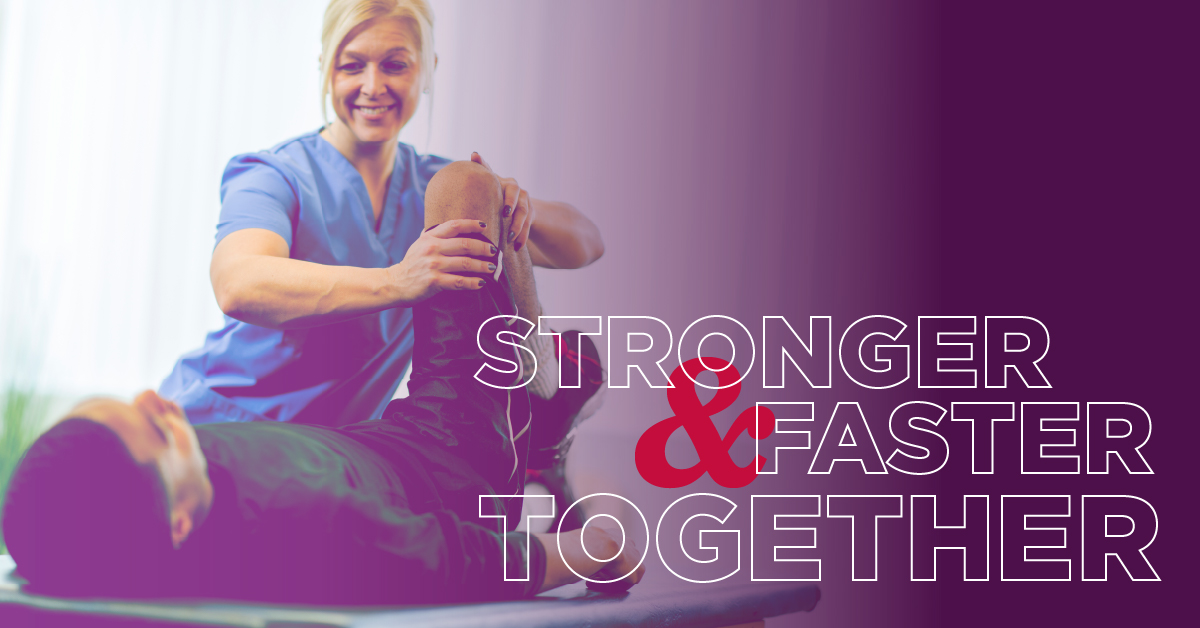
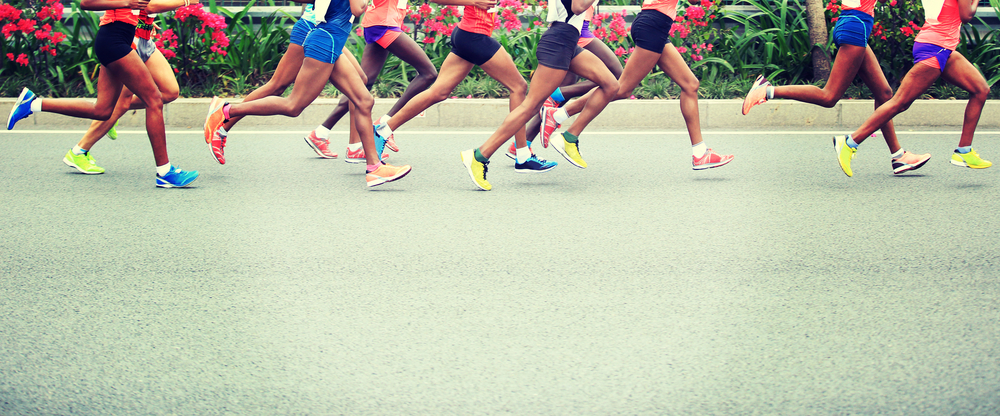

 Mr Maurice O’Flaherty MSc (Sports Med) FRCSEd (Tr & Ortho) is a Consultant Trauma & Orthopaedic Surgeon at UPMC Sports Surgery Clinic , specialising in Foot & Ankle Surgery, Trauma Surgery and Sports injuries.
Mr Maurice O’Flaherty MSc (Sports Med) FRCSEd (Tr & Ortho) is a Consultant Trauma & Orthopaedic Surgeon at UPMC Sports Surgery Clinic , specialising in Foot & Ankle Surgery, Trauma Surgery and Sports injuries.